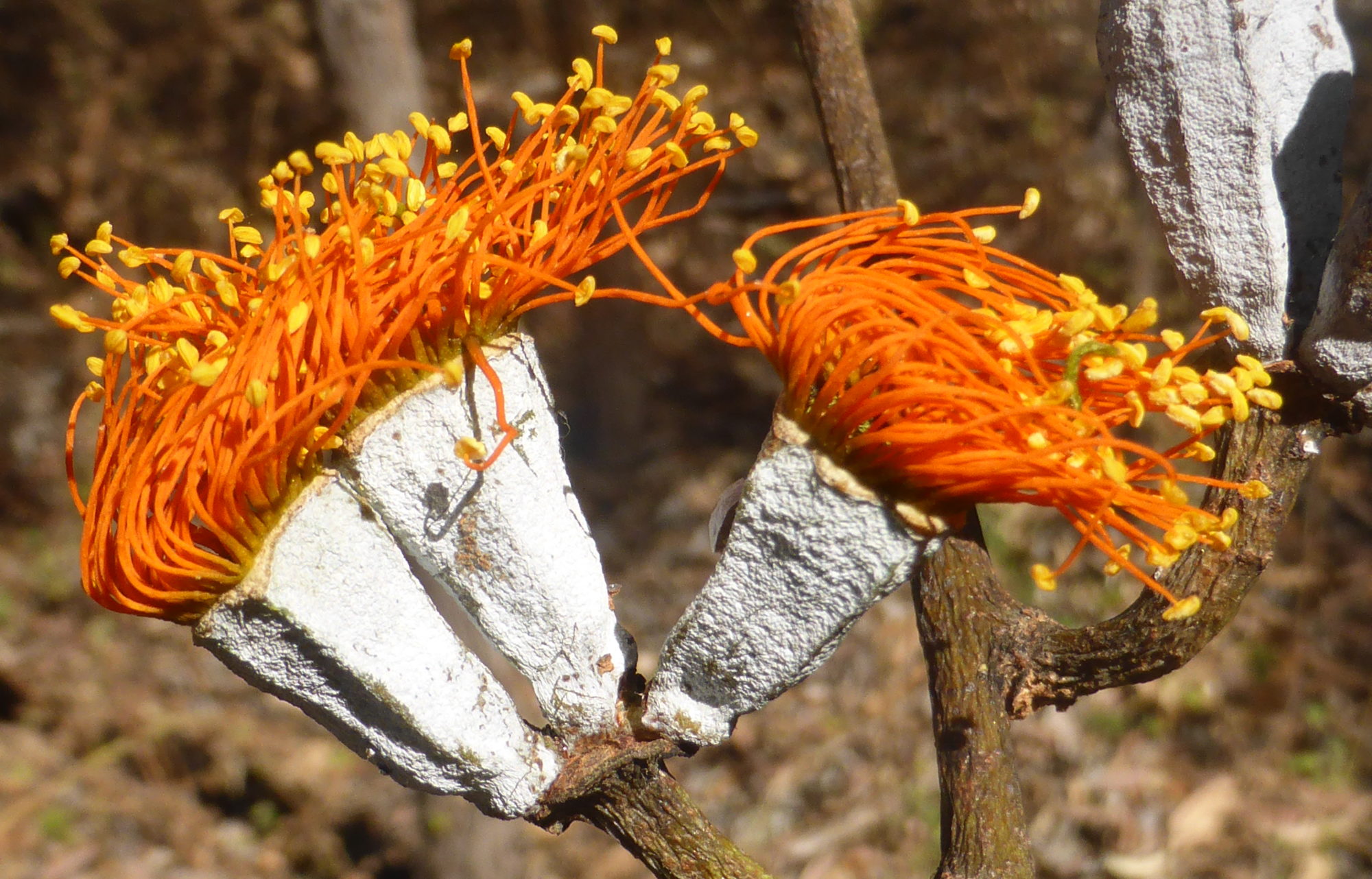Recently, I have been involved in surveys in the vicinity of the Eungella dam for an endangered native nightshade – Solanum graniticum.
Solanum graniticum is listed as endangered under both the Queensland Nature Conservation Act 1992 and the Commonwealth EPBC Act. This species is a ‘spindly, prostrate to sprawling, herbaceous…resprouting’ subshrub in the tomato family (Solanaceae), and was named by Queensland Herbarium taxonomist Tony Bean in 2004. It was recently elevated to endangered under the EPBC Act based on a nomination submitted by Jason Halford in 2019.

Solanum graniticum grows 20-30 cm tall, and may sprawl to a diameter of 1 m or so. It has spines to 9 mm long on the stems and the upper leaf surfaces (Bean, 2004) (and apparently on the lower leaf surface, although the specimens I examined closely did not). The leaves are shallowly to deeply lobed with 2-3 lobes per side, and are relatively small (to 2.6 x 1.3 cm). The lower leaf surface and the stems have a mid-dense to dense covering of stalked, stellate hairs. The upper surface has sparse-very sparse smaller stellate hairs (Simon Danielsen, pers obs).
This species is easily recognisable, and within its known range should not be confused with any other Solanum (Halford, 2019).
Solanum graniticum is endemic to north Queensland between Mackay and Townsville, where it is thought to be restricted to three disjunct populations (each are at least 100 km from the other). Each population is conservatively estimated to contain less than 250 individuals (i.e. the total species population is estimated at <1000 overall) (Halford, 2019):
- Cape Gloucester population: Cape Gloucester is the peninsula forming the south-eastern extent of Port Denison, 22 km directly south-east of Bowen. Until our surveys, this population was thought to be the largest of the three, although the species is described as rare (Halford, 2019).
- Mt Zero-Taravale population: a single collection was made in 2012 from the Mt Zero/Taravale wildlife sanctuary, 80 km west of Townsville in the Paluma hinterland (AVH, 2023). This population is 280 km from Cape Gloucester and 340 km from the Eungella dam. Population size here is unknown (estimated at less than 250 individuals at any one time – Halford, 2019).
- Eungella Dam population: a handful of plants were known from two adjacent collections on a hill-top directly overlooking the dam wall, in 2003 and 2011 (AVH, 2023). Halford (2019)
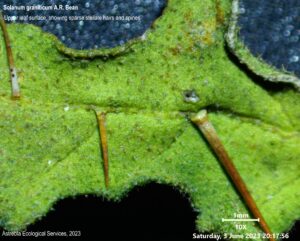
Solanum graniticum occurs in shallow soils derived from granite and granodiorite. It is most commonly associated with woodlands and open woodlands dominated by the ironbark Eucalyptus drepanophylla or E. crebra, with Corymbia erythrophloia, Lophostemon confertus, Allocasuarina littoralis and Corybia leichhardtii also noted as present in collection records (Halford, 2019; AVH, 2023).
Unfortunately for ecologists wishing to conduct targeted surveys for the species, E. drepanophylla/crebra woodland on granite soils are not in short supply in these areas, and this makes narrowing down a search area very difficult. This blog will attempt to assist this process by outlining where S. graniticum was found and my observations in relation to micro-habitat the species occupies in the vicinity of Eungella Dam (note – these observations may be of limited value to the other two populations, in particular the Mt Zero/Taravale population).
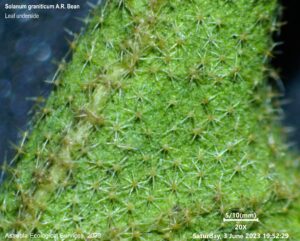
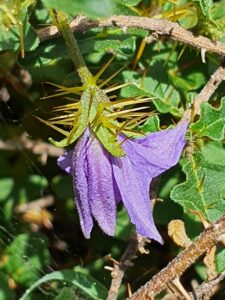
Survey findings
We found 101 individuals present in 10 sub-populations occupying approximately 88 ha, within an overall local extent of occurrence of 2360 ha (and I have reliable anecdotal evidence of another 14 plants in the vicinity). All potential habitat thought present has not been covered to date and it is highly likely the population within this extent of occurrence is considerably larger. The largest sub-population found was 5.2 ha in area and contained 41 plants. Another 35 plants were recorded within a 25 ha area nearby. One plant was found on the eastern side of the Broken River, less than 100 m from the high bank, on an apron slope.

Area of occurrence (AOO)
The spread of records from our surveys indicates an area of occurrence for the Eungella Dam population alone of 40 km2 (10 grid squares of 2×2 km as per the IUCN guidelines). However, using knowledge gained from these surveys in relation to habitat preference, and the distribution of that habitat type in the local landscape, I estimate that S. graniticum could have an AOO in the vicinity of the Eungella Dam of up to 80 km2.
The current documented AOO for the species is 28 km2 (Halford, 2019). Therefore, based on the findings of our surveys, total AOO for S. graniticum is now confirmed to be 68 km2, and could be as high as 108 km2 if our habitat projections are correct. This suggests that the Eungella Dam population is the prime population for the species, contributing more than 50% of the AOO.
Given these findings and their assumptions (ie that the vast majority of individuals present have been located), it is projected that the Eungella Dam population may contain 200-300 plants overall, which supports Jason Halford’s population estimate (Halford, 2019).
The extent of occurrence (EOO) for the species will not change as a result of these findings. In addition, the total estimated population size for S. graniticum of less than 1000 plants (Halford, 2019) appears to be supported.
Phenological observations
We observed S. graniticum flowering (profusely!) in November 2022. Previously, it has only been recorded flowering in March.
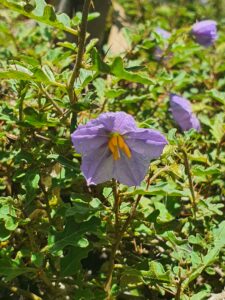
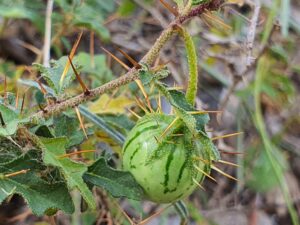
Microhabitat and survey observations
Solanum graniticum is a sprawling, low-growing (mostly less than 20 cm high) sub-shrub that, if not flowering, is easily overlooked. It is also genuinely absent from large areas of apparently suitable habitat – habitat that is common and well-represented in the Eungella Dam area. This makes it difficult to survey for. It is sometimes present as an isolated single plant with no other individual occurring within many hundreds of metres. The highest density recorded was nearly 8 plants per hectare, but this was unusual.
The plants we recorded were always growing in the RE 11.12.1 – woodland almost entirely dominated by E. drepanophylla. Corymbia erythrophloia and/or C. dallachiana were an occasional presence (i..e associated). In places, plants grew directly adjacent to the RE 11.12.16a (woodland dominated by Corymbia citriodora), but despite searches no individuals were located in that RE. It is also possible the species occurs in the RE 11.12.7, which is E. crebra woodland with vine thicket elements, although this RE tends to occupy steep slopes, and we did not find S. graniticum on steep slopes.

The woodlands in which it was found were grassy, with the predominant ground species being the exotic pasture grass Bothriochloa pertusa* (Indian bluegrass). We did not find S. graniticum where the ground layer had a dominant native species composition. This could be because such a ground layer (dominated by Heteropogon contortus, Themeda triandra, Cymbopogon refractus etc) is taller and more complex, and S. graniticum would be much harder to spot (as noted by Jason Halford).
Ground layer species associated with our records included Aristida gracilipes, Heteropogon contortus, Rhynchosia minima, Indigofera pratensis, Cyanthilium cinereum. Lantana camara* and Lophostemon confertus were present in places.
Solanum graniticum was occasionally found in open woodland mapped as non-remnant or regrowth, but despite numerous searches in adjacent cleared habitat, it was not located where there was no tree cover.
Individuals recorded during these surveys were also always associated with gently undulating slopes, usually on broad ridgelines but also on low rises and plains. We did not record it on hillsides or in gullies except very close to the ridgeline, although there was generally suitable habitat present on the hillsides. It was also only found where there was some soil development, and was not recorded where soils were skeletal with abundant surface cobble.
In addition, the plants we found were almost invariably situated adjacent to an object – usually a fallen log or the base of a tree, but occasionally among rocks. It could be that these structures provide protection from trampling, as all the areas we found S. graniticum individuals in were grazed.

References
AVH, 2023, The Australasian Virtual Herbarium, Council of Heads of Australasian Herbaria, https://avh.ala.org.au/. Accessed 3/6/2023.
Bean, A.R., 2004, The taxonomy and ecology of Solanum subg. Leptospermum (Dunal) Bitter (Solanaceae) in Queensland and far north-eastern New South Wales, Australia. Austrobaileya 6 (4): 639-816.
Halford, J.J., 2019, Nomination form to change the conservation class of Solanum graniticum in Queensland. Dept. of Environment and Science, Brisbane.
